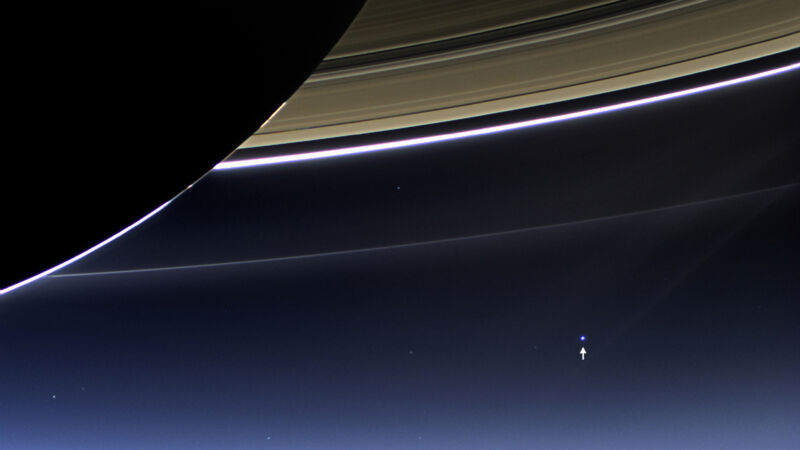
The search for extraterrestrial intelligence (SETI) has primarily involved looking outward and searching nearby stars for signals that can't be explained by known natural processes. But there has also been consideration given to the possibility that an extraterrestrial intelligence might be looking for us. Investigations have included intentional signals sent to nearby stars and calculations of how far out our civilization's radio transmissions will reach.
A new study focuses on the question of who might be capable of detecting us and considers how we're looking for signs of life around other stars. The study estimates that the Earth is surrounded by thousands of star systems from which hypothetical inhabitants would be able to detect our presence via the same techniques we've been using to search for life around other stars. And civilizations orbiting a significant number of those stars would also be able to detect things like oxygen in our atmosphere or the radio signals we have produced over the last century or so.
A shifting landscape
The new analysis, done by researchers Lisa Kaltenegger and Jacqueline Faherty, relied on data from the European Space Agency's Gaia mission, which was put in space to generate a three-dimensional map of the Milky Way. But the Milky Way isn't static; its stars rotate in synchrony, but they also move relative to each other. For many stars, repeated observations by Gaia also allowed an estimation of their motion relative to the Sun. This allowed Kaltenegger and Faherty to extend their analysis forward and backward in time, creating a window 10,000 years wide and centered on the present.
The size of this window is important because the stars closest to the Sun will tend to have the largest relative motion. Therefore, the orientation of their view toward the Sun will change more rapidly than that of distant stars.
Our most successful method of finding exoplanets has involved looking for transits—periods when a planet's orbit takes it between its host star and the Earth, allowing it to block some of the star's light. Because we know the orientation of the Earth's orbit relative to the rest of the Milky Way, it's possible to figure out what stars are in a position to observe our transits. And because we can run the clock forward and backward in time, we can identify which stars have been in a position to detect us in the past or will move into a position to do so in the future.
In most cases, we don't know whether planets orbit these stars, and there's no indication of life out there. This is simply a calculation of positions from which observing Earth would have been possible.
My god, it’s full of stars
Kaltenegger and Faherty limited their analysis to the nearest 325 light-years—that's 100 parsecs for those confused by the random-looking number. But even that figure is a bit arbitrary. We've identified exoplanets much farther out than that, while we'll only be able to study the atmospheres of rocky planets within 30 light years or so for the next few decades. The authors also looked within a 100-light-year radius because that's the rough distance our radio transmissions will have reached.
As it turns out, plenty of stars could have spotted Earth. The two authors count over 2,000 of them, with the vast majority being able to detect Earth's transits at present. (Three hundred and thirteen have lost the ability to image Earth, but another 319 will move into position over the next 5,000 years.) For about two-thirds of these stars, Earth's transits would last for at least 10 hours, making them relatively easy to spot; 868 of them will spend over 10,000 years in locations where the transits would be visible. So overall, there are a lot of opportunities to see Earth among this population.
Are any of these systems likely to host life? There are two bits of relevant data. One is the star type, which is mostly favorable. Roughly 200 of the stars are Sun-like, and over 1,000 are M dwarfs, a smaller, redder star that is the most common type in the galaxy. The rest are a mix of smaller and larger stars, including 75 white dwarfs.
The other relevant data point is the presence of planets. Based on estimates of the frequency of rocky planets found in the habitable zone of their stars, Kaltenegger and Faherty estimate that there would be over 500 planets with the potential to be Earth-like. Seven stars within the 325-light-year radius have confirmed planets. But the list includes TRAPPIST-1, which has seven known planets; one other has at least two. So this list of seven stars represents significantly more planets (although TRAPPIST-1 won't be in a position where the Earth could be detected for another 1,600 years or so.)
The other radius that Kaltenegger and Faherty looked at was 100 light-years, the area that our radio transmissions would have reached since the invention of the medium about a century ago. There are 117 objects in that region, 46 of which have had extensive observational time within the past 100 years. The number includes four of the stars known to host planets; based on the frequency of rocky planets, 29 of them could be within this region.
Signs of life?
Five thousand years ago isn't an especially relevant interval, as it's well after the origin of agriculture and the formation of the first cities (although only the former might be detected from a distance). Perhaps more relevant is the origin of the steam engine and the large surge in carbon emissions that it eventually produced. The elevated carbon dioxide might be detectable from space, although natural events can also cause a surge in carbon dioxide levels. Really, the most compelling indication of life here that could be detected from a distant star is likely to be the simultaneous presence of oxygen and methane in the atmosphere at the same time. And that, as Kaltenegger and Faherty note, would take us back to the oxygenation of the Earth's atmosphere, about a billion years ago.
So any life on a nearby planet is likely to have had a substantial amount of time when it might have been able to detect Earth and study our atmosphere—assuming those aliens used methods similar to the ones we developed, at least. But it's also worth noting that life on Earth needed well over 3 billion years to develop those methods, and it remains unclear how long we'll be able to maintain them.
Nature, 2021. DOI: 10.1038/s41586-021-03596-y (About DOIs).



3175x175(CURRENT).thumb.jpg.b05acc060982b36f5891ba728e6d953c.jpg)

Recommended Comments
There are no comments to display.
Join the conversation
You can post now and register later. If you have an account, sign in now to post with your account.
Note: Your post will require moderator approval before it will be visible.